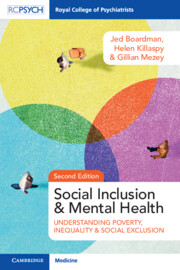Book contents
- Social Inclusion and Mental Health
- Reviews
- Social Inclusion and Mental Health
- Copyright page
- Contents
- Foreword to Second Edition
- Foreword to First Edition (2010)
- Preface
- Acknowledgements
- Chapter 1 Introduction: Poor, Excluded, and Unequal
- Section 1 Social Exclusion, Poverty, and Inequality
- Section 2 Participation of People with Mental Health Conditions
- Chapter 9 Mental Health Inequalities and Exclusion
- Chapter 10 Exclusion from Material Resources
- Chapter 11 Exclusion from Socially Valued Activities
- Chapter 12 Exclusion from Social Relations and Neighbourhoods
- Chapter 13 Exclusion from Health and Health Services
- Chapter 14 Exclusion from Civic Participation
- Chapter 15 Social Exclusion in Specific Social Groups and Individuals with Mental Health Conditions
- Chapter 16 Social Exclusion and People with Mental Health Conditions: Developing a Clearer Picture
- Section 3 Including People
- Index
- References
Chapter 10 - Exclusion from Material Resources
from Section 2 - Participation of People with Mental Health Conditions
Published online by Cambridge University Press: 24 November 2022
- Social Inclusion and Mental Health
- Reviews
- Social Inclusion and Mental Health
- Copyright page
- Contents
- Foreword to Second Edition
- Foreword to First Edition (2010)
- Preface
- Acknowledgements
- Chapter 1 Introduction: Poor, Excluded, and Unequal
- Section 1 Social Exclusion, Poverty, and Inequality
- Section 2 Participation of People with Mental Health Conditions
- Chapter 9 Mental Health Inequalities and Exclusion
- Chapter 10 Exclusion from Material Resources
- Chapter 11 Exclusion from Socially Valued Activities
- Chapter 12 Exclusion from Social Relations and Neighbourhoods
- Chapter 13 Exclusion from Health and Health Services
- Chapter 14 Exclusion from Civic Participation
- Chapter 15 Social Exclusion in Specific Social Groups and Individuals with Mental Health Conditions
- Chapter 16 Social Exclusion and People with Mental Health Conditions: Developing a Clearer Picture
- Section 3 Including People
- Index
- References
Summary
This chapter outlines the levels of poverty, debt, and financial hardship in people with mental health conditions, the social security system, and living conditions, including neighbourhood deprivation, housing, and transport. People with mental health conditions are more likely to be excluded from material resources than others in society. They are over-represented in low-income group, those living in poor housing, and deprived environments. They are likely to be in debt or have other financial difficulties and to be receiving inadequate amounts of state benefits. The severity of the condition and its longevity exacerbates the degree of exclusion. There appears to be a two-way relationship between mental ill-health and material deprivation: social and environmental aspects of material exclusion play a role in the cause of mental ill-health and mental ill-health leads to material exclusion. Poverty mediates the relationship between mental health conditions and the many other social problems that people face, as well as impeding their ability to cope with their mental health difficulties. People’s responses to poor conditions are universal and, for those with mental health conditions, may be more appropriately seen as a consequence of their impoverished circumstances rather than due to their mental health conditions.
Keywords
- Type
- Chapter
- Information
- Social Inclusion and Mental HealthUnderstanding Poverty, Inequality and Social Exclusion, pp. 194 - 226Publisher: Cambridge University PressPrint publication year: 2022



